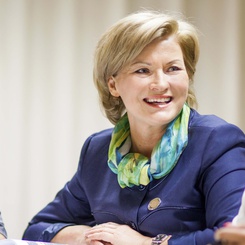In the light of the US election campaign and the diversity issues it has raised, Viviane de Beaufort, Professor at ESSEC Business School, Co-Director of the European Center for Law and Economics and Academic Director of the Program "Women in Entrepreneurship", shares her research into women and their relationship with power
Will Hillary Clinton join Angela Merkel, Margaret Thatcher, Christine Lagarde, Indira Ghandi, Erna Solberg, Golda Meir and, most recently, Theresa May, in reaching the highest levels of power? The world holds its breath and for more reasons than one: any leadership change at the head of the world’s most powerful nation will obviously have a ripple effect – perhaps even shock wave, depending on the result – over the rest of the world’s community of nations. Meantime, Hillary Clinton pursues her path to voting day, perhaps – most likely, even – from time to time raising her head to think for a few moments on her relationship with power and how good a job she would do if the vote swings in her favor.
As such, Hillary Clinton resembles many other women with either the capacity and/or the ambition to rise to the top. Viviane de Beaufort has carried out extensive research on the position of women in business and politics, including two working papers published in recent years – Women and Their Relationship to Power: Still a Taboo or a New Corporate Governance Model? and Women and Corporate Governance: Towards a New Model. Many of her findings can be directly linked to the US election campaign: not only Hillary Clinton’s ambition to hold power (how will she perform and will it be different from a man?), but also voter behavior (how do they perceive power and the role of women, and what will tip the scales to make them potentially vote for Hillary?).
Women and power: A complex relationship
The progression of gender diversity within business leadership raises an important question: Do women have a different relationship and approach to positions of power than their male counterparts? To answer that question, Viviane De Beaufort went directly to the source, interviewing female board members, company directors, civil servants, politicians and experts in France and abroad, asking them how they felt about their role and the particular qualities they brought to it.
The initial results were surprising: participants rarely talked specifically about power. Surprising in the sense that both the workplace and boards of management are undeniably places of power in which women clearly wish to take on the roles of authority within business. So why does this striking omission of the word power exist? Is the word still taboo?
Part of the answer lies in the fact that ambition still carries different connotations for women and men. Many of the answers gathered indicated that the battle for power was still perceived as a masculine issue and one that women confront with difficulty.
Strikingly, a large majority of those women interviewed stated that they did not build their career in connection with an aspiration to power. As one interviewee said, “I never drove to become an Executive Director as a clear game plan; I only looked for the opportunity to have a position that would allow me to influence and develop people independent of which position I could do that from.” Another respondent reasoned that “we live in a male power place… women are not naturally considered as potential leaders by male CEOs because they are still driven by criteria based on “manhood” values and reflexes to promote what resembles them.”
Walks like a woman and talks like a man…
Lola – the classic 60s song by the British group The Kinks from which the sub-title takes its inspiration – may have a ring of truth about it when tackling the gender role-model issue: at times it can be all rather confusing. Indeed, does a major problem facing women aspiring to positions of authority lie in the fact that they are trying to fit in to the masculine model of power? There is perhaps an initial effect of denial in the question: some refuse to attribute specific qualities or behaviors to women – even when the dominant HR literature identifies in the female gender a style of leadership, or intuitive moral qualities, that are different. In that light, there is a risk that the female minority in positions of power will attempt to conform to the male majority, ignoring the fact that women should have a right to exercise that power differently. Consequently, asserts Viviane de Beaufort, women should do all they can to promote their unique values and their unique managerial practices.
It is generally agreed that there are still many barriers today that make it more difficult for women to reach positions of power. But some of these barriers are self-applied. Working closely with psychologists in order to better understand women, their relationship with power and how it differs from the masculine model, de Beaufort observed that results illustrated that there was a negative connotation attached to the term ‘power’. Many women, for example, felt that power came at the cost of their serenity, associating it with ‘power games’. They felt that power could be an ‘isolating’ factor.
That said, interviewees among the surveys were quick to identify ‘feminine’ qualities that set their managerial qualities apart from their male counterparts. These qualities were identified as a greater ability to listen, a capacity to analyze subjects in greater depth, a middle-of-the-road perspective and daring to keep their ego out of the way. Conscious of the danger of generalizing, it was found overall, however, that women in power are more frank, possess a real concern to make things move forward, and feel strongly about ethics. Finally, women place a great deal of importance on perceived legitimacy.
Generalization is made more difficult by the fact that many variations in approach are linked to the socio-cultural setting. Three areas stood out in the studies which did not seem obviously linked to geographical zones, but more to prevalent governance traditions: an Anglo-Saxon world, contexts in which socialist ideals predominate and emerging countries where male/female gender equality is an ongoing struggle.
A quota policy for women Presidents?
‘The issue of gender quotas is very complex and one that should be approached with caution,’ states Professor de Beaufort. Although her expertise is focused to a large extent on gender issues, she is hesitant when asked the question ‘quota or not?’ On the one hand, quota regulations can have a ripple effect, forcing businesses to confront the issue and encouraging women to take on roles of authority because the path has been made possible. On the other hand, they can sometimes also be a source of resentment. As one respondent said, ‘Quotas, by imposing legal constraints, forces companies and organizations to think about gender issues – even when they dislike the issue – and to put in place previously lacking processes to identify women’s talents.’ Moreover, quota policies also push male leaders to think outside of the box on what a company needs at each level of their organization and in particular at the top level. As they are required to find women to fill the spaces, they are forced to modify their criteria of leadership, including both practical questions – time spent at the office, for example – and ethical questions – the bullish behavior that is often confused as representative of leadership.
But regardless of whether or not quotas hold the key to gender diversity on boards, the paradigm in which women exercise power is of the utmost importance: a paradigm in which leadership integrates rationality and intuition and where the ideal manager of either gender blends stereotypically ‘male’ skills (charisma, leadership, impartiality, decision-making capability, etc.) with the stereotypically female (rationality, empathy, listening, organization, knowledge, etc.). The question begs: Does Hillary Clinton demonstrate the perfect example of this ideal leadership paradigm?
Let’s get practically-minded
All in all, companies (and society at large) can no longer ignore the question of parity between men and women at the top of the hierarchical ladder. While the personal motivation of women seems better adapted to the more flexible company model, the development of new game-changing models will help overcome any persistent notions that still reject the power of women. However, promoting women to positions of power only makes sense if it enables the latter to bring, in terms of skills and behaviors, a difference. This means facing up to the masculine model to build a mixed leadership model that integrates the feminine quotient.
The fact that women wishing to access power – and within this article’s specific context, boards of governance – share a demanding, even idealized, vision of how these influential bodies should function, means that they are participating in the construction of a ‘long-lasting governance’ model which is both demanding and perhaps more adapted to confront the challenges that a board – or government, if the image is stretched to the wider perspective of Hillary Clinton and the US leadership – is faced with in our disruptive world. Women, in this light, are potential drivers of positive change.
Useful links:
- Viviane de Beaufort in the European Business Review: The Obstacles to Women's Entrepreneurship in Europe, and How to Deal with Them
- La féminisation: une source de renouveau pour les conseils d’administration
- Le pouvoir fait- il encore rêver les femmes ?
- Vidéo : Du Bon Usage des Réseaux









